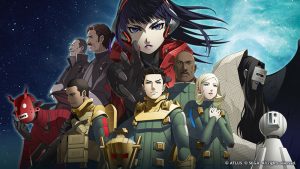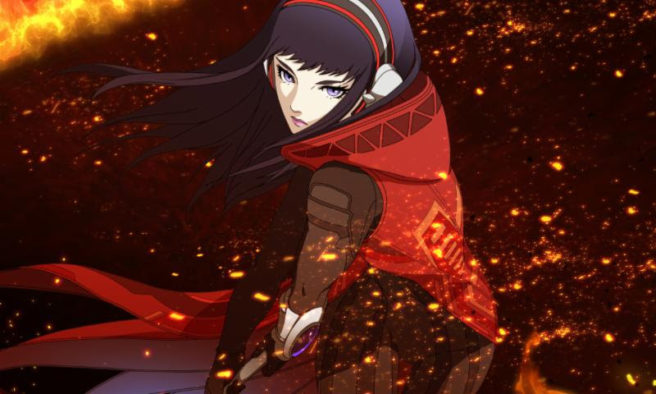Shin Megami Tensei: Deep Strange Journey dev FAQ – setting, characters, difficulty, series’ future, much more
Posted on April 12, 2018 by Brian(@NE_Brian) in 3DS, General Nintendo, News
Personal Opinions:
Q: Since religious imagery and symbolism play a huge part of your games, do you have a favorite myth, lore, or culture/religion that’s not your own that you find particularly fascinating or inspiring?
Eiji Ishida: I think the impact that religion has on someone will differ from person to person, but what personally interests me the most is what form some of these religions initially started in. Naturally there are religious figures who are considered deities in a more traditional sense, but I like the kinds of beings that humanity created to answer a need, like the yōkai that are born from Japanese folklore.
I also like the idea of godlike beings born from a shift in values as the times change, like “Media” from “American Gods” by Neil Gaiman, because those gods are strange, yet believable.
Q: Would you like to make another military-themed Shin Megami Tensei game?
Eiji Ishida: Yes, if it’s possible, I’d like to create a continuation of this game, but lately I’ve been wanting to try creating a story with a setting that is more like a slice of life. Perhaps something like a secret academy where demon tamer students gather would be interesting.
Q: Which alignment do the devs choose when getting to play the games after finishing development?
Eiji Ishida: While the game was in development, I had to play it over and over and over and over… and over even more, so honestly, I don’t want to touch this game for at least a couple of years. Personally, I like the Neutral Route, so I think I’d choose that route if I were to play. But then again, if I play it based on how I honestly feel, I’d probably end up in the Chaos Route without me even noticing it… (lol).
About SMT Lore, its History, and Future:
Q: What is the criteria that the developers use to select demons to put in the compendium? The diversity of the deities and demons present in the games are one of the best SMT characteristics that make the games unique.
Tatsuya Watanabe: Our criteria for the demons we select is based on the theme of the game and its story. There are no relative merits when it comes to how popular or unknown the demons are.
Personally though, I’d like to select an obscure deity that can’t be found online as one of the main pillars of a newly introduced demon. If I do a web search on that deity after the game’s release and see a Shin Megami Tensei-related page in the results, that will definitely put a smile on my face.
Q: What is the timeline of all Shin Megami Tensei games? Do the events of all the Shin Megami Tensei games occur in the same universe or dimension?
Eiji Ishida: This game takes place in a world and timeline that is different from the other entries in the Shin Megami Tensei series. The Demonica Suit does appear in Shin Megami Tensei IV too, but there are no timeline connections between them. Had they been connected, perhaps we could’ve included some interesting crossovers, but there is no need to have any knowledge of the other games to play this one.
Q: Are there plans for a default female main character, or at least the option of a female MC for future titles?
Eiji Ishida: This would depend on each game’s director, but if I ever am given the chance to make another Shin Megami Tensei game, I’d like to consider such options. By the way, though it was never released in the US, “Shin Megami Tensei If…” for the Super Famicom [SNES] allowed you to choose the gender of the protagonist.
Q: Any plans expand the moral options to the game beside the classic chaos/neutral/law? Perhaps it could include something like we have seen in the Witcher, Mass Effect or Fallout New Vegas, to name a few.
Eiji Ishida: This would also depend on each game’s director, but if I ever am given the chance to make another Shin Megami Tensei game, I think I would like to expand on that aspect. However, I am also interested in working on a project with a storyline that does not branch off. I would like to write a story similar to “The Last of Us,” which follows the very personal journey of one man. I have been particularly interested in these types of works lately.

About the Process & Development:
Q: What is the team’s writing and planning process like? How do you choose which demons might take a bigger role in the narrative of a single entry in the games?
Eiji Ishida: Since video games are an interactive form of entertainment, we think that what’s most important is what we call an “experience-based theme” where we consider what we want the player to experience through the game. For Strange Journey, a game system and story with theme of “exploration” was taken into consideration. By doing this, the game system and story can unfold in the same direction, allowing for a level of cohesiveness between the two. The player is taking part in is an investigation party with exploration as their goal, so the game system became one where you expand and improve your abilities to further this exploration.
As for the selection of demons important in the story, we consult staff members that excel at thinking through such things and other members that design such demons. For Strange Journey, the final enemy is XXXXX (spoilers!), so we concentrated on choosing XXXXX-like deities for the demons that take on important roles. When we choose demons based on the prerequisites of the story, we are able to select demons that are persuasive and match the story’s world setting, but as a result, this does limit our selection process and decreases their variations. That is the difficult part of trying to make this work.
Q: How do you research your information for demon designs what sources do you look at to find stories from mythology from around the world and how do you incorporate that into the final design?
Masayuki Doi: It all begins with going through the materials such as books, mythology-related websites, and other resources put together by the person in charge of the story setting. And based on those materials, I sketch out details that could be used in designing the demons and characters, and then I discuss which is the best design amongst the team. Whether their designs remain faithful to the original mythologies or certain aspects are exaggerated is decided through this process.
Q: What inspires you guys to keep writing the stories you create? And how do you come up with settings and area designs?
Eiji Ishida: I’ve only directed Strange Journey in the Shin Megami Tensei series, but I think that the story depicted in the SMT series isn’t as simple as a showdown between demon invaders and innocent humans. I believe that the series has continuously depicted the clashes between complex ideologies and the cooperation that forms between people. With that in mind, occurrences that can easily be used as themes in such stories constantly take place in the real world we live in, for better or for worse. I believe that there are many instances where we gain inspiration from such human actions.
As for the area design question, the first half of Strange Journey’s dungeons were designed as spaces that are the materialization of the negative karma that mankind has cast upon the Earth, such as environmental destruction. They can also be taken as direct messages from the Earth of how mankind must reflect on the actions they have taken.
Q: How do you come up with these unique character designs in each game?
Masayuki Doi: This process isn’t too different from how I design demons, but I think about what parts of the character to emphasize through the materials put together by the person in charge of the story setting. For example, in regard to Alex, her role in the story is contrastive to the Red Sprite’s crew, so while I was designing her I was mindful to give her a different equipment set and silhouette than the Red Sprite’s crew. As a result, I believe that her final design is a contrast to the others and is uniquely different from them.
Q: At any point, were there plans to have a Shin Megami Tensei game take place completely in the Western world (with the exception of SJR) or worldwide?
Eiji Ishida: I cannot answer concerning what we have lined up for the future, but as I answered earlier, I do daydream about different possibilities. Some of those include having one take place in space, or making one take place in Hell and the protagonist is a low-class demon who strives to become the commander of Hell’s army. Either way, these may be fun ideas to pursue.
Q: Does fan input from surveys contribute to any of the recent projects and/or ideas?
Eiji Ishida: For this remake, we took a lot of player feedback into account. It might be difficult to see if you compare the original and the remake side by side, but quite a number of improvements have been made based on the players’ opinions, which should create a more enjoyable gameplay experience.
Q: How have modern games, developed by ATLUS or otherwise, influenced the direction of the Shin Megami Tensei series, which is over 20 years old at this point?
Eiji Ishida: Strange Journey is the only title I was involved in as a director, so I cannot say anything to summarize it all, but I think that there are constant outside influences. It’s hard to answer in detail what kind of influences because there are too many of them, but since we keep making games where the player must clash with others who have different beliefs, I’ve been influenced by games that depict such conflicts (and alliances). Still, this influence isn’t just from video games. I think that I’m influenced by movies, novels, and even real-life incidents.
I can’t say in detail since I haven’t played this game yet, but how Far Cry 5 attempts to integrate social backgrounds that are very difficult to handle into the game world is impressive to me, as a creator myself, and I commend their bravery on tackling such themes.
